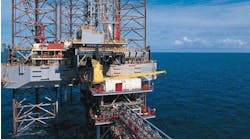Frank Hartley • Houston
Intervention string
With many wells past peak production, well interventions are being used to prolong productivity. As revenues from such wells are already substantially reduced, these interventions must be extremely cost-effective. AnTech Ltd. introduced the COLT interven-tion string to address the problem.
The intervention string incorporates a host of sensors that measure critical downhole conditions, including temperature, load, and gamma ray. Also, the system is designed to pump through while offering a range of information. As a result, the engineer has instant access to data that offers a timely and accurate picture of what is taking place downhole.
Vibrasave protects the intervention string from vibration and shock and improves the reliability of the drilling bottomhole assembly by reducing the effects of vibration on the tool string. According to AnTech, the system is robust and has withstood rigorous vibration while operating in Southeast Asia, Alaska, and the Middle East.
AnTech's COLT intervention string incorporates a host of sensors that measure critical downhole conditions, including temperature, load, and gamma ray, with the ability of pumping through the center.
Associated with the intervention string is the company's quick-connect system, which allows components of the tool string to be made up and broken down easily. The primary advantage, the company says, is that the string can accommodate up to eight electrical connections running through it, while still allowing for upwards of 1 in. for hydraulic flow for pumping operations. The straight hydraulic flow path that runs through the center of the tool minimizes any pressure drop throughout the length of the tool string, giving more pressure for intended operations. It also has the added benefit of reducing the vibrations transmitted from the fluid to the tool, thereby increasing reliability.
An electrical release also means that there is no reason to prepare for possible over-pressure or over-pulling, inadvertently causing release. The release mechanism is continually monitored, acting as an indicator that the electrical circuit is operational and ready-to-use.
The system can be fitted with an electrical actuator that serves as a pointing device used to point within a 3° angle for use in search operations, such as fishing or identifying a sidetrack.
Oilwell fishing operations
Oilfield drilling operations have at least one recurring problem: something in the hole that is broken, stuck, or otherwise not a part of normal operations will have to be retrieved or removed. Equipment failure, human error, and the impossibility of foreseeing every problem mean the need for "fishing" will never be eliminated.
The Guide to Oilwell Fishing Operations des-cribes basic guidelines and best practices for successful fishing jobs. Fish-ing jobs fall into three classifications: open hole with no casing in the area of the fish, cased hole with fish inside the casing, or thru-tubing with fishing through a smaller pipe size restriction. Stuck or broken tubulars, drill collars, bit cones, dropped hand tools, sanded-up or mud-stuck pipe, and stuck packers are typical examples of fish. Washovers, overshot runs, spear runs, wireline fishing, stripping jobs, and jar runs are among the many fishing techniques discussed.
Operator often budget for a fishing operation in the planning stage of a complicated well. When a workover is a planned procedure, the operator works with a fishing tool company to design a procedure and estimate costs. This guide places special emphasis on planning, communication, and job preparation.
Fishing is a "risk management" tool that can save a well. Seldom are two fishing jobs alike, yet many are similar. A variety of tools and methods can be applied. Experience usually indicates the best way when all factors are considered. Experience and continuing advances in fishing tool technology offer a good probability of success.
Thru-tubing fishing systems run on coiled tubing are used to retrieve many types of fish. When wireline fishing is unsuccessful, coiled-tubing conveyed fishing gives the operator another alternative before a conventional rig workover is required.
Early thru-tubing fishing tools were designed for wireline conveyance and did not take advantage of coiled tubing capabilities. These tools did not allow circulation through the tool, and early tools modified to allow circulation had restricted flow paths. They also lacked the tensile strength required to handle the impact loads of jarring systems developed for coiled tubing use. Some tools developed for other coiled tubing services such as inflatable packers proved inadequate for fishing applications. Tools had to be designed specifically for thru-tubing fishing operations. Thru-tubing fishing tool technology has advanced dramatically in the last decade, and individual tool components can now be assembled to meet much more demanding applications.
The Guide to Oilwell Fishing Operations provides a basic understanding of fishing problems and solutions. It reviews typical problems that require fishing in cased hole, open hole, and thru-tubing. Tools and techniques are described, including a section on casing exits and subsea plug and abandonment. Specific tools and techniques for coiled-tubing conveyed, thru-tubing fishing operations are also des- cribed. Additionally, tool-string hookup design for common thru-tubing fishing operations is reviewed. Illustrations, photos, charts, tables, and formulas accompany the text. A glossary and bibliography provide additional reference. For more information, see www.gulfpp.com.
New hydrate inhibitor introduced
Baker Petrolite has introduced a new hydrate inhibitor in the HI-M-PACT inhibitor product line, based on innovative third-generation anti-agglomerant technology. The new inhibitor technology is designed to reduce the cost of hydrate control in deepwater wells, flowlines, and facilities by replacing high-volume methanol treatments.
The company says the hydrate inhibitor treatments are designed to be effective at significantly lower dose rates than those used in methanol programs. Lower dose rates result in improved logistics, reduced operating costs, smaller facilities, and reduced capital cost, as well as the elimination of crude oil penalties for methanol contamination. The hydrate inhibitors are also designed to contribute to a safer working environment by replacing toxic and flammable methanol. Since 1999, HI-M-PACT low-dosage hydrate inhibitor systems have been applied in the Gulf of Mexico, West Africa, and the North Sea.


